Real-Time Location Systems (RTLS) - How They Transform Industrial Automation
Industrial RTLS (Real-Time Location Systems): underlying technologies, offerings, and benefits. How they drive supply chain automation in manufacturing and logistics.
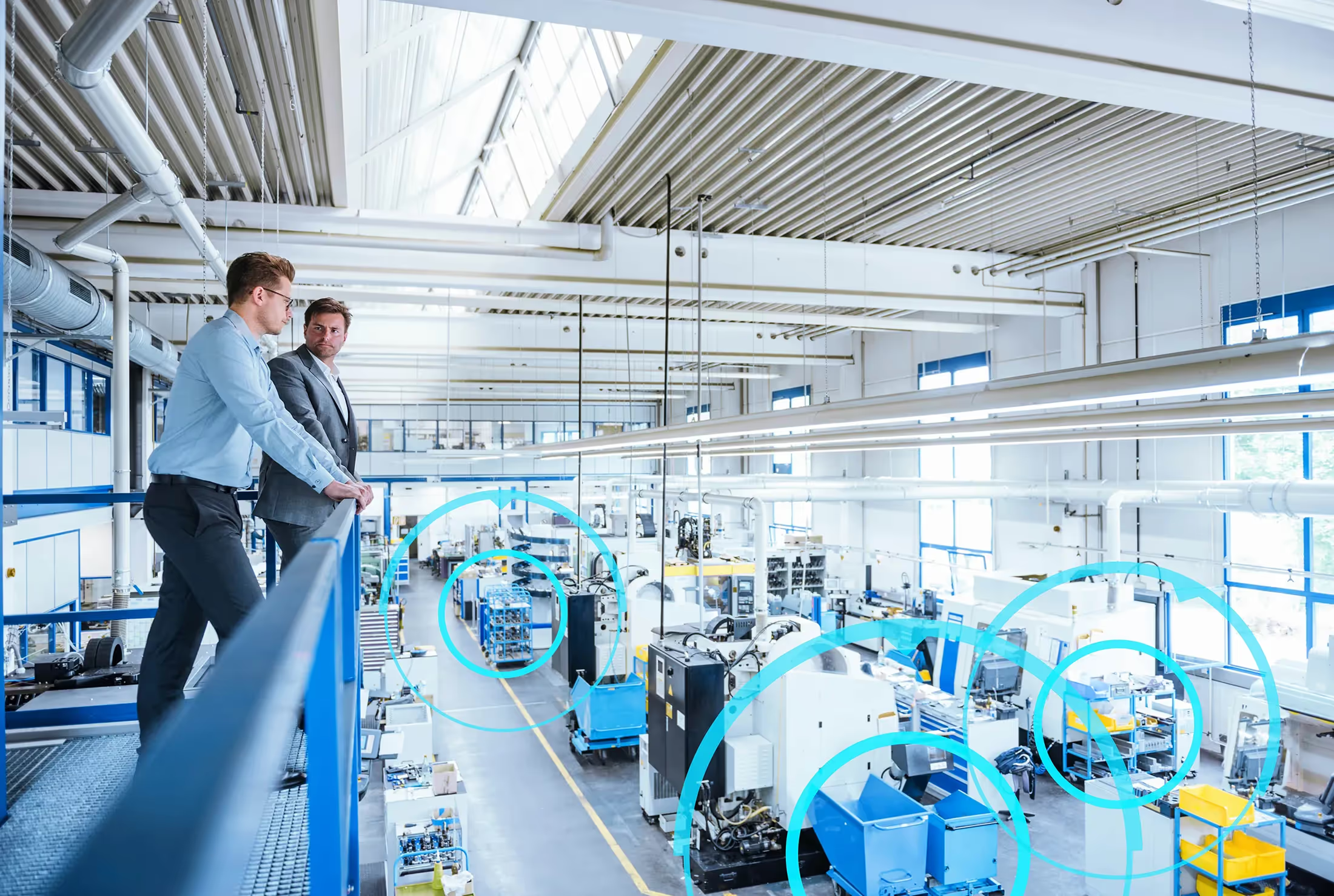
Real-Time Location in Manufacturing and Logistics
Tracking mobile and stationary assets such as manufactured goods, transport vehicles, machines, tools or containers is a key prerequisite for the automation and optimization of logistics and production processes in Industry 4.0. To reliably orchestrate complex operations in these industrial environments, the location and status of involved objects must be continuously tracked. Real-Time Locating Systems (RTLS) consisting of sensors, receivers, network and control systems provide the technical infrastructure for automated, continuous monitoring.
What is RTLS?
RTLS, meaning Real-Time Location System and sometimes also referred to as RTLS systems, is a key technology for the automated localization and tracking of objects in real time, usually within a specific business area, e.g. industrial production or warehouse. Combining wireless communication, localization algorithms and centralized monitoring, RTLS system provides accurate real-time data on the positions of tagged objects, enabling businesses to effectively track and manage their assets and processes. This makes real-time locations services a key prerequisite for industrial process and supply chain optimization and automation.
How does RTLS work?
A RTLS system typically uses radio frequency signals such as BLE, GPS, RFID, UWB or WiFi technology to locate assets in a defined area. Each asset to be tracked is equipped with a sensor that emits radio signals. These signals are collected by a series of receivers located throughout the monitoring area. The receivers triangulate incoming signals to determine the exact location of each object using localization algorithms. Depending on business requirements, the position of each tagged object can be precisely calculated.
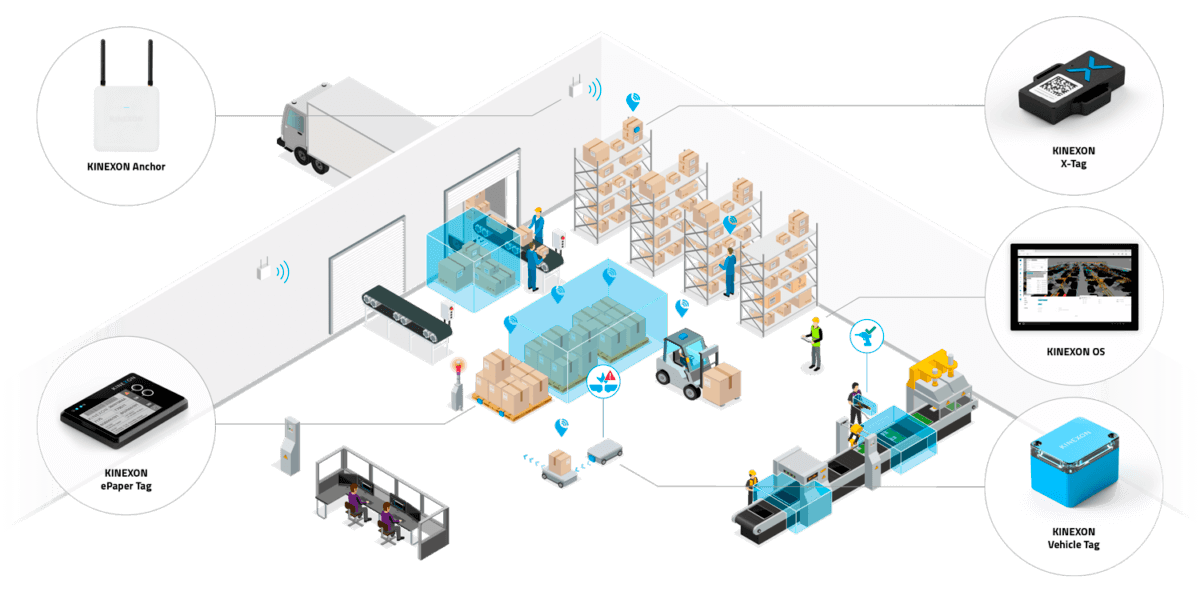
RTLS Tracking: Bluetooth/BLE, GPS, RFID, UWB, WiFi
Various technologies are available to enable effective communication between hardware and software components in industrial RTLS tracking systems, depending on the specific requirements. Whether a technology is suitable for a particular application essentially depends on whether objects need to be tracked continuously or just from time to time, whether this process needs to be automated and how accurate the localisation needs to be.
Common RTLS tracking systems and technologies in a nutshell
- Bluetooth Low Energy (BLE) offers low-power communication over short distances and is usually used indoors. It is very suitable for frequent updates without reducing battery life and is therefore suitable for warehouses and factories.
- Global Positioning System (GPS) enables accurate tracking outdoors using satellite signals. It is particularly suitable for monitoring vehicles and shipments in large areas, but is less effective indoors due to signal obstructions.
- Radio Frequency Identification (RFID) uses electromagnetic fields to track tags on objects. Active RFID tags have their own power source for communication over longer distances, while passive tags rely on signals from connected readers.
- Ultra-wideband (UWB) provides high-precision indoor tracking with high accuracy. Its wide frequency range minimizes interference, thus making it the ideal choice for manufacturing, asset tracking and automatic vehicle navigation.
- WiFi-based tracking uses existing WiFi infrastructure to track devices and assets. It offers a good balance between accuracy and cost and is suitable for industrial environments with extensive, seamless WiFi coverage.
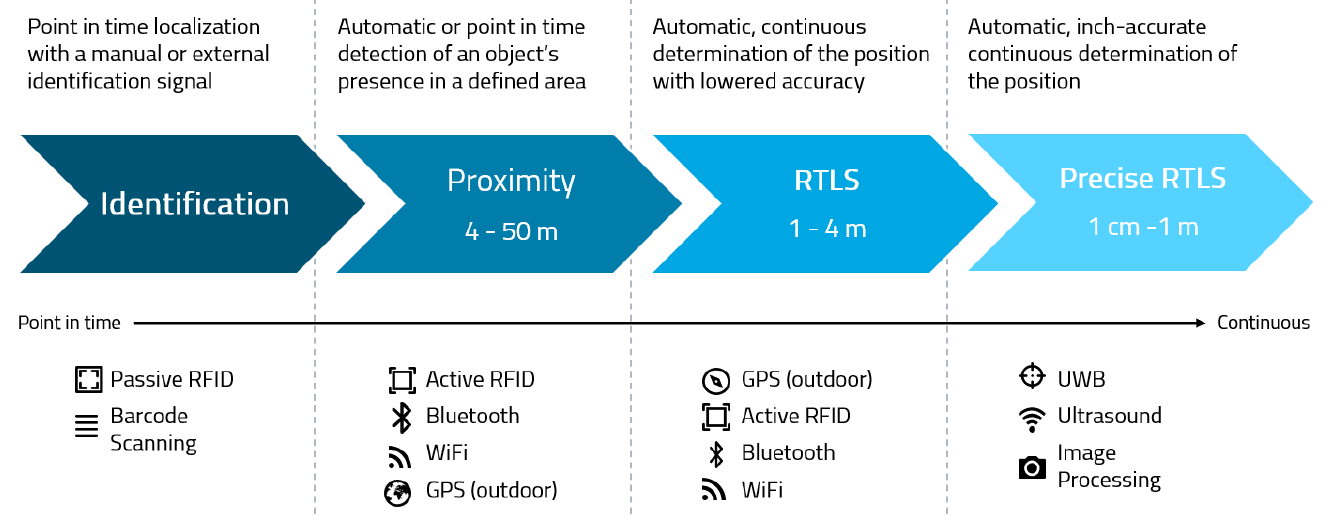
With the growing demand for more accurate, comprehensive and immediate data, businesses are adopting real-time positioning systems to complement or replace their RFID solutions. UWB is recognised as the most accurate, reliable and dynamic RTLS technology and is therefore the gold standard for ultra-precise RTLS. The following comparison highlights the differences between RFID and UWB RTLS.
What Is the Difference between RFID and UWB RTLS?
Real-time location systems using RFID have been a key technology for wireless object identification in manufacturing and logistics for decades. With an increasing number of industrial assets and people moving through factories and warehouses, UWB-based real-time localization has become a more powerful alternative to RFID-based RTLS. The main difference between (passive) RFID and UWB RTLS is in the localization data they generate: while RFID provides selective point-to-point data, UWB is designed to deliver continuous, seamless real-time data across a defined space.
Key benefits of UWB RTLS technology:
- Accuracy: high-precision localization technology
- Responsiveness: real-time capability
- Stability: no interference with WiFi or BLE versions commonly used in the industry
- Flexibility: various use cases within one infrastructure
- Robustness: long-term operation without maintenance intervention
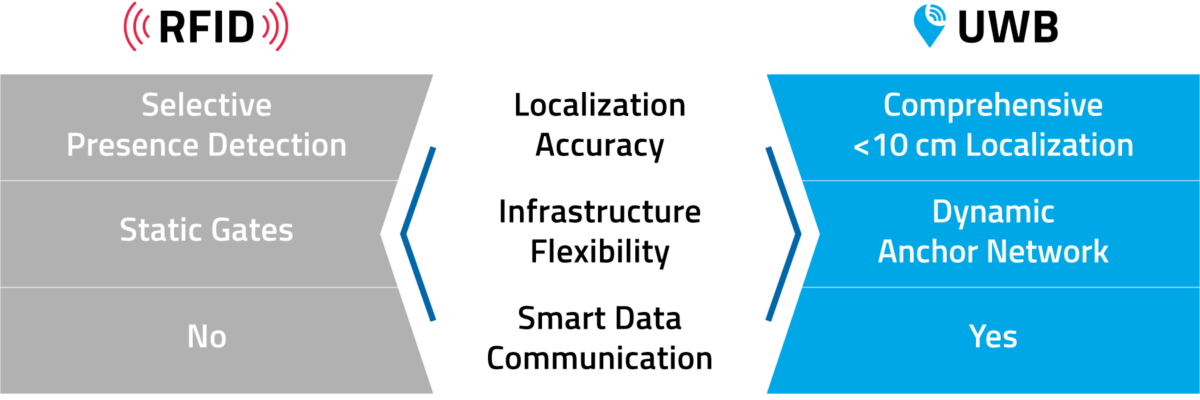
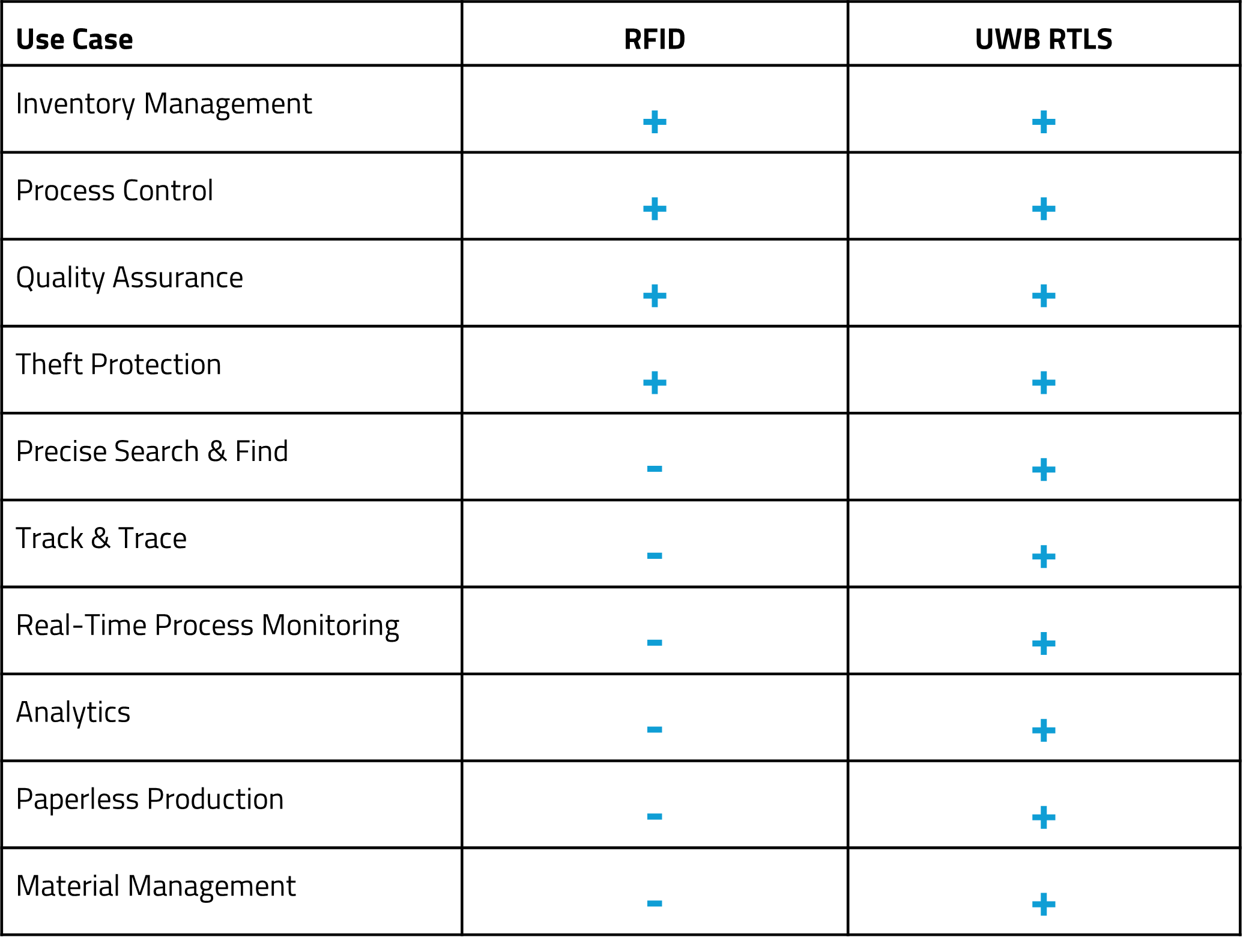
RTLS Localization: TWR, TDoA, AoA and PDoA
UWB combines short light-speed pulses and accurately measures signal arrival time over a wide bandwidth for high-precision transmitter positioning, reaching distances of up to 200 meters in line-of-sight. There are various methods available to achieve this, which differ in their accuracy, energy consumption and suitability in fast environments with a large number of assets to be tracked. The most common methods are presented here.

Two-Way Ranging (TWR): Using TWR the highest precision and position stability can be reached. This method is preferred for localization of people and tools. It is furthermore the go to method for navigation of driverless automatic guided vehicles (AGV).
Time Difference of Arrival (TDoA): Localization using TDoA is characterized by the lowest power consumption compared to the other methods. In an industrial environment TDoA is primarily used with larger numbers of objects.
Angle of Arrival (AoA): Calculating the position based on the angle of arrival, the direction of the signal relative to the anchor and the signal strength allows greater precision with minimum infrastructure.
Phase Difference of Arrival (PDoA): Determining the sensor position based on the phase difference between the received signals at both anchor antennas and the angle of the signal relative to the anchor allows the RTLS to be implemented in restricted infrastructures.
Modern real-time positioning systems combine multiple localization technologies to deliver high-precision tracking in industrial environments. KINEXON RTLS uses TWR (Two-Way Ranging) and TDoA (Time Difference of Arrival) to provide maximum accuracy while maintaining energy-efficient operation.
RTLS Hardware: Tags and Anchors
The hardware components of an industrial RTLS include tags and anchors - mobile devices attached to assets to be tracked that transmit signals and static ones that receive these signals, determine real-time positioning of assets and forward them for processing.
RTLS Tags: Mobile sensors that are attached to the objects to be tracked. Tags emit signals received by the so-called anchors. There are different types of tags, including active tags with their own power source, e.g. a battery, that can transmit signals over long distances, and passive tags, relying on an external power source, e.g. a reader. There are also tags with and without a user interface, e.g. a small screen to display the current asset status.
RTLS Anchors: Stationary receivers that are placed across the industrial environment to receive signals from the installed tags. These anchors collect data on the arrival time, strength and angle of the signal and then transmit this information to the RTLS software for centralized processing and control. RTLS anchors usually have their own power supply, e.g. through integration into a Power-over-Ethernet (POE) infrastructure or regular power grid.
Learn about the KINEXON RTLS Hardware
RTLS Software: Control Center and Coordinator
While hardware, anchors and tags, is an essential component of RTLS systems, any smart solution requires powerful software to unlock the true value of location-based process automation - regardless of the technology used to generate real-time location data. A sophisticated RTLS software platform integrates tracking technologies and location data, enabling operators and decision makers alike to automate operations and gain actionable insights from location data.
Coordinator: Software that runs on a server or on a Virtual Machine (VM) to which the anchors are connected. The coordinator controls the synchronization of anchors and tags and processes the anchor data to create position data in real time.
Control Center: User interface for the RTLS, which in modern systems is a web-based application. All relevant information, such as the current system status, the available devices or the current system settings, is displayed in the Control Center.
Discover the powerful KINEXON OS software platform

What Is the Difference between IPS and UWB RTLS?
The terms Indoor Positioning System (IPS) and Real-Time Locating System (RTLS) are often used synonymously. In fact, both refer to systems that are designed for tracking and monitoring moving or stationary objects in industrial environments. In addition, both are mostly used for indoor production and intralogistics applications.
At a technical level, IPS and RTLS differ in one key feature:
- RTLS solutions are network-centric systems where the location of assets is tracked and reported to the back-end server and control software, providing this information to the user. Typical application: Locating e.g. goods, tools etc.
- IPS solutions are device-centric systems, telling the asset its position and reporting the location to the user of the device (usually via a smartphone app). Typical application: Navigating e.g. driverless vehicles (AGV), for example.
Industrial Applications for RTLS
Real-Time Locating Systems (RTLS) are taking supply chain processes to the next level by providing businesses with high-level supply chain visibility and control over systems and processes, unlocking a great potential for automation. From industrial asset and production order tracking to assembly line control, RTLS enables businesses to increase efficiency, productivity and safety while reducing operating costs. As industries continue their digital transformation, the adoption of RTLS will undoubtedly play a crucial role in a company’s future success.
Track Everything, Everywhere – Indoor and Outdoor RTLS
With advanced RTLS technology, you can seamlessly track people, assets, and equipment across both indoor and outdoor environments. Whether it’s navigating complex warehouse layouts, monitoring vehicles in real time on a sprawling campus, or ensuring safety across multiple sites, RTLS provides precise location data wherever it’s needed. Beyond real-time tracking, RTLS enables a wide range of use cases:
Order Tracking & Process Management
Automated order tracking and process management helps optimize industrial operations and reduce costs. Companies achieve maximum order transparency and track production orders in real time. Accurate insights into physical manufacturing processes allow for effective quality control and automatic material replenishment.
- Real-time order tracking: Automate processes by eliminating manual bookings and scans to save time and costs.
- Automated quality control: Increase production and process quality with real-time monitoring and timely alerts of errors and bottlenecks.
- Efficient material replenishment: Avoid material shortages and process idle times by optimizing just-in-time delivery of material to the production lines.
Learn more about Order Tracking & Process Management with KINEXON
AMR & AGV Fleet Management
The level of automation can be further increased by combining AMR/AGV control with real-time location systems. With KINEXON OS software platform and KINEXON IIoT devices, companies connect and manage resources beyond mobile robots. By combining both solutions, further manual effort is eliminated and operational efficiency is increased.
- Process stability with real-time manufacturing monitoring: RTLS enables real-time monitoring of manufacturing and supply chain processes, improving stability and increasing efficiency.
- Automate order creation process: RTLS minimizes setup times and simplifies order creation for faster turnaround times.
- Transport safety of autonomous vehicles: RTLS prevents collisions between autonomous vehicles and forklifts, ensures safe transport processes.
More about AMR & AGV Fleet Management with KINEXON
Asset Tracking in Manufacturing and Logistics
Industrial Asset Tracking enables businesses to efficiently manage materials, tools or semi-finished goods. Movable assets are digitized to easily track their location and improve transparency for employees. Automated flows of tagged assets can be managed more efficiently to identify and reduce bottlenecks.
- Inventory management: Eliminate search times and increase industrial asset visibility to save operational costs.
- Process flow management: Manage and optimize the work-in-process status of any industrial assets involved in production processes.
- High-value asset tracking: Efficiently monitor and manage high-value assets with greatest accuracy and reliability.
- Specialty equipment tracking: Receive real-time notifications and documentation of rule violations related to the movement and quantity of speciality equipment.
Explore more about Asset Tracking with KINEXON
Assembly Line Control
Using RTLS, businesses reach the next level of flexible and efficient assembly automation. By tracking the location of vehicles and tools in real time, manual assembly processes can be automated and production managers enabled to intervene immediately in emergencies.
- Automated vehicle identification: Accelerate assembly by eliminating manual scans for vehicle identification.
- Automated tool approval: Increase assembly quality by controlling manual assembly tool operations.
- Assembly line operator: Leverage flexibility of assembly processes to seamlessly apply new requirements.
Discover more about Assembly Line Control with KINEXON
Do More with RTLS
With RTLS technology, you can go far beyond simple tracking – it unlocks a wide range of possibilities to optimize operations, protect people, and gain valuable insights. By knowing the precise location of assets, equipment, and staff in real time, organizations can make faster, safer, and smarter decisions. Some powerful use cases include:
- Worker safety – monitor high-risk areas, send alerts in emergencies, and ensure compliance with safety protocols.
- Workflow optimization – analyze movement patterns to remove bottlenecks and improve process efficiency.
- Compliance and reporting – automate documentation and audits with accurate, real-time data.
- And more
When an RTLS is connected to the digital world—including MES, ERP, and WMS systems—it can create end-to-end supply chain visibility, providing a complete picture of operations from production to delivery. This integration allows businesses to anticipate issues, streamline workflows, and make fully informed decisions at every stage of the supply chain.
RTLS empowers your business to create a safer, more efficient, and data-driven environment while bridging the gap between the physical and digital worlds.
How KINEXON Helps Unleash the Power of RTLS
The KINEXON Real-Time Locating System is designed for fast update rates and maximum positioning accuracy. Thanks to the versatile portfolio of sensors (tags), the KINEXON RTLS Pro is able to cover a wide range of application scenarios, including order tracking & process control, asset tracking and automated assembly line production.

The KINEXON RTLS Pro system provides businesses with all the hardware and software components they need to efficiently automate their industrial processes. The latest UWB technology ensures maximum performance and reliability. In addition, the system is highly scalable and can be easily expanded by adding further anchors as required.
Learn more about the KINEXON RTLS Pro
The KINEXON OS software platform collects and processes location data in real time to respond flexibly to manufacturing and logistics operations and enable intelligent decisions for key processes. The platform is highly flexible, scalable and allows businesses to aggregate location and identification data from various sources and complements contextual information from third-party IT/OT systems such as ERP (Enterprise Resource Planning), MES (Manufacturing Execution System) and WMS (Warehouse Management System).
More Resources
Stay Up to Date
Subscribe to our newsletter and stay connected. You can unsubscribe at any time.
Ready to automate your industrial operations?
Schedule a meeting with our experts to connect and automate your operations.
Get in touch